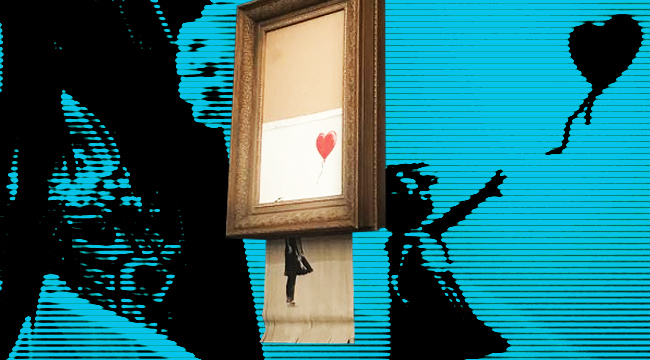
There is this idea, floating out in the world, of “good mischief.” It appears in pop culture and comes up in conversations — this dream of doing good by breaking the rules. The very notion feels incandescently cool, hinting at the last vestiges of our civilization’s renegade spirit. A trace of our rebel roots and a chance to cause chaos without hurting anyone.
It’s also a tough phrase to parse. What the hell does “good mischief” mean, in the literal sense? No credit for film, TV, or book references, either. We want actual examples, pulled from the real world.
Well, over the weekend we got one — street artist Banksy’s “shredder in a painting” stunt. It was a bold move and a wild story, cutting through the static to captivate millions. It was also absolutely joy-inducing to watch. A bunch of art auction suits rubbing their temples in baffled anguish? Sign us up. That moment where the Sotheby’s staff took the painting off the wall because they literally didn’t know what else to do? Gold. Straight up gold.
If you can see this and not smile, god help you:
https://www.instagram.com/p/BomXijJhArX/?taken-by=banksy
Before we go worrying that this little bit of levity had a human cost (some mega-rich person getting less mega-rich), it’s worth noting that by shredding “Girl With The Balloon” and creating a rare viral moment for the art world, Banksy likely tripled the value of the painting. Tate Modern in London absolutely needs the piece in their collection now, and they’ll pay heftily for it.
The only loser here is Sotheby’s because they’re legally bound to give the painting to its bidder, thereby missing out on reselling it for more money. Spoiler alert: They’ll be just fine.
While the piece seems pretty direct in its objective — to literally shred the commodification of creativity — there are hidden layers worth exploring: Is the painting worth more now that it’s in ribbons? Probably. Is that ridiculous, considering that the aesthetics of the piece are ruined? Possibly. Are we, as a culture, more interested in the shredded painting that created a viral moment than we are in the arrangement of actual brushstrokes on a canvas? Most definitely. And what does that say about us?
Sure Banksy addresses these issues with the subtlety of a jackhammer (he also famously sold his original art on the street for $20 a pop, circling this same point), but 21st-century art never cuts through the chaos when it’s indirect. The modern art scene’s disconnect with the real world, the reckless ways the mega-rich spend money as the wealth gap increases, and our absurd habit of paying for things (purses, paintings, clothes) without asking ourselves about their greater inherent value, are all themes that are ripe for attack.
Also, forget the shredder scraps, this image should be in MOMA:

Art aside, the real lesson here is about fighting the establishment with good mischief. A little controlled chaos is a nice trick to get the blood flowing. Reminds us that we’re alive. It’s a rare true-to-life example of a concept which has become increasingly theoretical. We might call ourselves pirates, smugglers, and iconoclasts in our social media bios, but society is, more than ever, pushing us toward strangled uniformity.
One of the natural byproducts of our current social movement is to sand down everyone’s rough edges. To quell the scamps and brigands, often for the better. The inevitable endgame of our populace waking up to its own equality gap is recognizing that the chasm that separates criminals from the “mischievous” has historically been a matter of privilege.
Not to put too fine a point on it, but when good ol’ rednecks broke the law they were dashing gentlemen of fortune; when black people did it they were superpredators. The “boys being boys” excuse of the 80s — which treated young men spying on women through peepholes and hidden cameras in Meatballs and Revenge of the Nerds like mere rascals — feels absolutely revolting when we see Brett Kavanaugh, a product of that sort of thinking (who came of age in the years those movies were released), get a seat on the highest court in the land.
Even Banksy, who used to pretend to be painting walls as part of a legal urban design project has certainly benefitted from white privilege (the artist’s identity is well-established), while black and Latin taggers get jailed. Roll your eyes if you must, but the fact of the matter is that American and Western European society’s tolerance for mischief of any variety has historically been just as slanted towards straight white males as everything else. The version of Ferris Bueller’s Day Off featuring any other race in 1986 would end with its protagonist in county lockup.
And yet… while the very concept of good mischief needs an update, we do need it. We’ve got to keep a little fresh air flowing through society. The chance to bend (or even shatter) the rules on occasion is part of what makes us human. And thumbing our noses at failed systems is a way to fight against them. Not bending to the status quo is our best means for resisting the massive machines that seem to be grinding us all down to a pulp. Bansky’s choice of target — the famously “up its own ass” art world — is well deserving of a prank like this, but there are even better targets waiting in the wings.
Moving forward it will be interesting to see who takes up the torch next. How can this concept be used as part of the bigger resistance movement? How can it tackle issues larger than the historically myopic art world? Who wouldn’t want to see a little good mischief applied to the massive student debt system? Or the deeply racist NRA? Or youth hating Baby Boomer senators? Or absolutely anyone opposing the pursuit of increased equality in our world?
As society evolves, there’s still a place for good mischief. It’s not about pranks, it’s about speaking truth to power. It’s a celebration of the trickster spirit that was so vital to the actual founders of this nation. Banksy laid down the gauntlet. Hopefully, it’s a trend — a tool used by those helping to steer our society to a better place while mocking the systems that slow our progress down.






